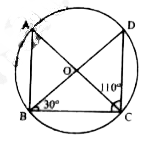ABCD is a cyclic quadrilateral whose diagonals intersect at a point E. If ∠DBC=70∘,∠BACis30∘, find ∠BCD. Further, if AB = BC, find ∠ECD.

Step by step video & image solution for ABCD is a cyclic quadrilateral whose diagonals intersect at a point E. If angle DBC = 70^(@), angle BAC is 30^(@), find angle BCD. Further, if AB = BC, find angle ECD. by Maths experts to help you in doubts & scoring excellent marks in Class 9 exams.
Updated on:21/07/2023Topper's Solved these Questions
- CIRCLES BOOK - NAVNEET PUBLICATION - MAHARASHTRA BOARDCHAPTER - CIRCLES EXERCISE - EXERCISE 10.6
10 Videos
- CIRCLES BOOK - NAVNEET PUBLICATION - MAHARASHTRA BOARDCHAPTER - CIRCLES EXERCISE - SKILL TESTING EXERCISE
11 Videos
- CIRCLES BOOK - NAVNEET PUBLICATION - MAHARASHTRA BOARDCHAPTER - CIRCLES EXERCISE - EXERCISE 10.4
6 Videos
- INTRODUCTION TO EUCLID.S GEOMETRYBOOK - NAVNEET PUBLICATION - MAHARASHTRA BOARDCHAPTER - INTRODUCTION TO EUCLID.S GEOMETRYEXERCISE - MULTIPLE CHOICE QUESTIONS
3 Videos
Similar Questions
Knowledge Check
ABCD is a cyclic quadrilateral whose diagonals intersect at P. If AB=BC,∠DBC=70∘and∠BAC=30∘, then the measure of ∠PCD is:
Aa) 50∘Bb) 35∘Cc) 55∘Dd) 30∘ABCD is a cyclic quadrilateral whose diagonals intersect at P. If AB=BC,∠DBC=70∘and∠BAC=30∘, then the measure of ∠PCD is :
A35∘B50∘C55∘D30∘ABCD is a cyclic quadrilateral whose diagonals intersect at E. If ∠BEA = 80∘, ∠DBC = 60∘ and ∠BCD = 40∘, which of the following statements is true?
ABD bisects ∠ADCBAB=BCCDA=DCDAC bisects ∠BCD
ABCD is a cyclic quadrilaterial , find it's angles .

View SolutionIn cyclic quadrilateral ABCD, Diagonals AC and BD intersect at P. If ∠DBC=70∘ and ∠BAC=30∘ then find ∠BCD
View SolutionIn Figure, if ∠DBC=700 and ∠BAC=300, find ∠BCD. Further, if AB=BC, find ∠ECD
View SolutionIn this figure ∠DBC=30∘and∠BCD=110∘. Find ∠BAC

View SolutionABCD is a cyclic quadrilateral whose diagonals intersect at P. If AB=BC, ∠DBC=70∘ and ∠BAC=30∘, then the measure of ∠PCD is :
ABCD एक चक्रीय चतुर्भुज है जिसके विकर्ण एक-दूसरे को P पर काटते हैं | यदि AB=BC, ∠DBC=70∘ तथा ∠BAC=30∘ है, तो कोण PCD का माप क्या है ?
View Solution
